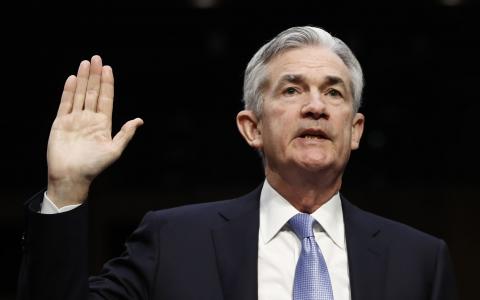
(Bloomberg) Traders and stock market pundits are talking about a “Powell put,” after Federal Reserve Chairman Jerome Powell presided over a decision in late January to ease off on rate hikes. It’s a callback to the fabled Greenspan put, which was the idea that Fed chief Alan Greenspan in the 1990s and early 2000s would never allow the stock market to fall too far.
Worth decoding is the Wall Street jargon: A put is a trade that pays off when shares fall. Investors can use it as a kind of insurance. But if you expect the central bank to step in and ease monetary conditions whenever the market gets anxious, that’s almost as good a safety net. Hence the notion of the Fed providing every investor with a put.
The reality, of course, is more complicated. Greenspan’s aggressive interest-rate cuts didn’t prevent the dot-com bubble from bursting, and Ben Bernanke’s reductions couldn’t stop a tailspin as the financial crisis unfolded. Still, both arguably helped fuel a recovery once stocks bottomed out. In the Janet Yellen era, pauses between hikes rather than cuts were what some called the Yellen put.
The drama surrounding Powell is that traders can’t quite figure out how low he’ll let the market go. From the start he’s shown some tolerance for stock market pain. He assumed the job a year ago as the economy was accelerating. The S&P 500 had surged 24 percent in the 12 months through January 2018. But it was amid a 10 percent retreat that Powell took the oath of office in early February. In remarks at his swearing-in ceremony, he said, “We are in the process of gradually normalizing both interest-rate policy and our balance sheet.” Traders took that to mean Powell wasn’t in a hurry to help them out.
It didn’t matter for long, because the market recovered as President Trump’s tax cuts fueled a surge in earnings, even as the Fed went on to raise its benchmark rate in March, June, and September. But after the third hike, which brought the upper end of the federal funds rate to an almost 11-year high of 2.25 percent, stocks started swooning. The S&P 500 was down about 13 percent from its record as the Fed met in December. Even that didn’t produce a Powell put: The central bank lifted borrowing costs a fourth time, and its Dec. 19 statement indicated that “some further gradual increases” in rates were ahead. The market went on to extend its fall to almost 20 percent from its record high before paring those losses.
Wall Street’s Fed watchers reacted in shock. Barclays Plc economist Michael Gapen called it “capitulation” in the face of a volatile market. George Saravelos, head of foreign exchange research at Deutsche Bank AG, referred to “regime change.” Tom di Galoma at Seaport Global Holdings LLC called it “one of the most dovish turnarounds” he’s seen in his 30-year career. Short-term interest-rate traders started betting more on rate cuts than rate increases.
Investors shouldn’t get carried away. “The market tends to hear what it wants to, rather than what is really being said,” wrote Brad McMillan, chief investment officer for Commonwealth Financial Network, a group of broker-dealers and advisers. “So far, what the Fed has said is that it is being patient with rates and intends to keep them as the primary tool of monetary policy. It did not say that policy will be loosening.”
The question now is what happens if stocks keep climbing and economic data strengthen enough to threaten one of the Fed’s main mandates, keeping inflation in check. Given Powell’s commitment to normalization, some think his put looks like it’s part of a more elaborate trade known as a “collar.” That’s a bet that the market will stay in a certain range. “We’ve shifted from a Fed put to a Fed collar,” Michael Collins, a senior portfolio manager at PGIM Fixed Income, told Bloomberg Television on Feb. 1. If stocks rally until the central bank’s next meeting in March, he worries the Fed will be “talking about another hike or two later this year. And maybe that limits the upside.”



